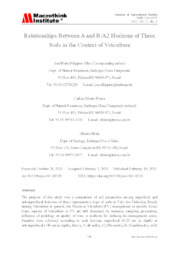Relationships between A and B/A2 horizons of three soils in the context of viticulture.
Relationships between A and B/A2 horizons of three soils in the context of viticulture.
Autoria: FILIPPINI ALBA, J. M.; FLORES, C. A.; MIELE, A.
Resumo: The purpose of this study was a comparison of soil parameters among superficial and sub-superficial horizons of three representative type of soils in Vale dos Vinhedos, Brazil, aiming Viticulture in general, but Precision Viticulture (PV) management as specific focus. Basic aspects of Viticulture or PV are still discussed, by instance, sampling procedures, influence of pedology on quality of wine or methods for defining the management zones. Samples were collected according to each horizon, superficial (0-20 cm in depth) or sub-superficial (>40 cm in depth), that is, A (all soils), A2 (Neossolo), Bi (Cambissolo), or Bt (Argissolo). Micro-vinification was performed for grapes derived from five classes of soil. The pedological parameters analyzed were granulometric fractions, chemical parameters and degree of flocculation. Data were organized according to a Geographic Information System (GIS) by ten classes of soil. Basic statistical analysis, line graphs, XY plots and factor analysis were used to interpret the physicochemical variables related to horizons, soil and wine. Relative Accumulation Indexes were evaluated for horizons of soil, classes of soil and wine. Data organized by horizon and type of soil showed great dispersion, so outliers were discarded and data organized by class of soil. Correlation of data related to soil horizons, A against A2/B, was evident for macronutrients. Micro-vinification altered content of K and P in wine. Relative Accumulation Indexes of soil horizons correlated to declivity, when declivity lesser than 20% occurred. Fe and Zn showed correlation among sub-superficial horizon and wine for some classes of soil.
Ano de publicação: 2021
Tipo de publicação: Artigo de periódico
Unidade: Embrapa Clima Temperado
Palavras-chave: Pedologia, Solo, Viticultura
Observações
1 - Por padrão são exibidas publicações dos últimos 20 anos. Para encontrar publicações mais antigas, configure o filtro ano de publicação, colocando o ano a partir do qual você deseja encontrar publicações. O filtro está na coluna da esquerda na busca acima.
2 - Para ler algumas publicações da Embrapa (apenas as que estão em formato ePub), é necessário ter, no celular ou computador, um desses softwares gratuitos. Sistemas Android: Google Play Livros; IOS: iBooks; Windows e Linux: software Calibre.
Acesse outras publicações
Acesse a Base de Dados da Pesquisa Agropecuária (BDPA) para consultar o acervo completo das bibliotecas da Embrapa.

